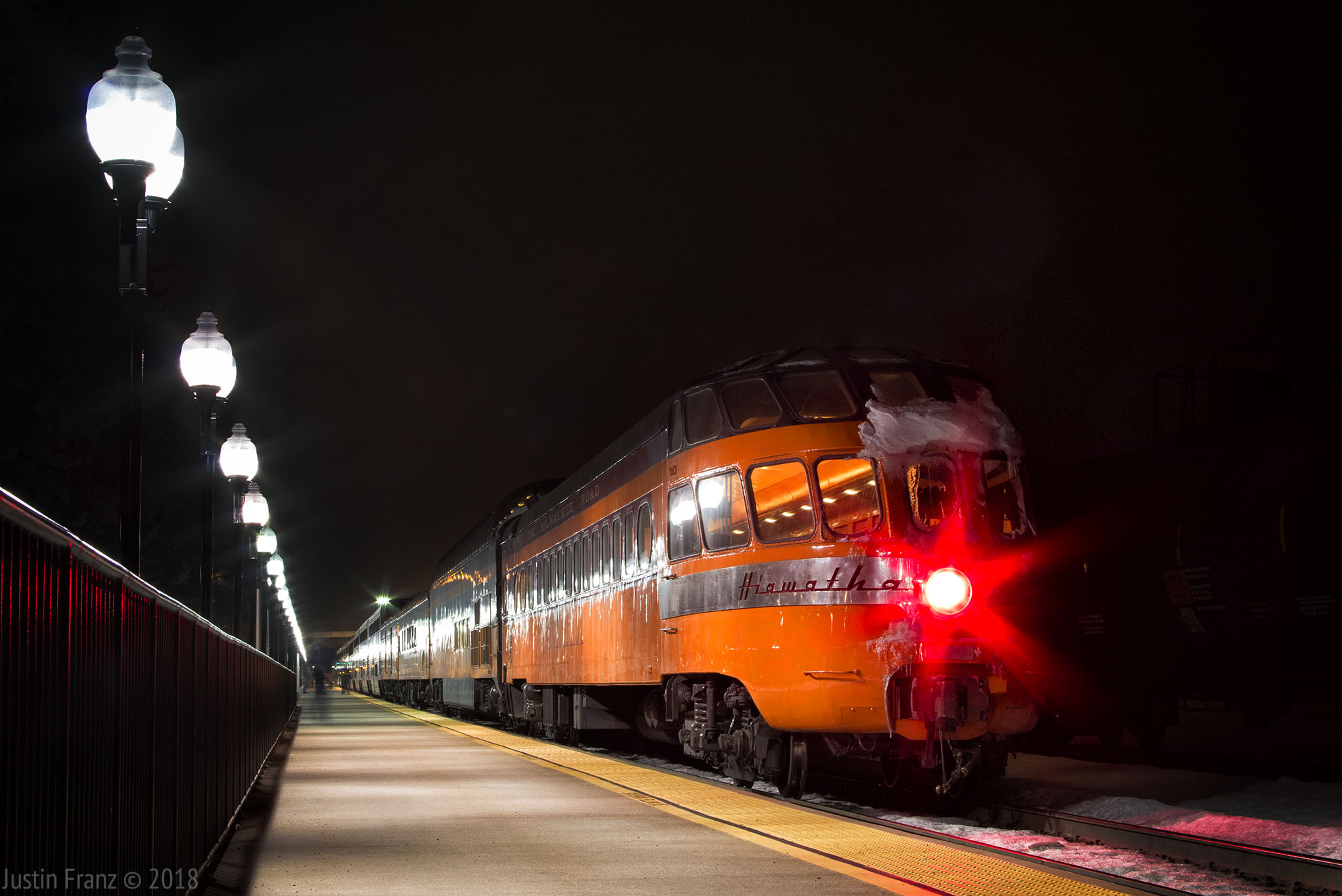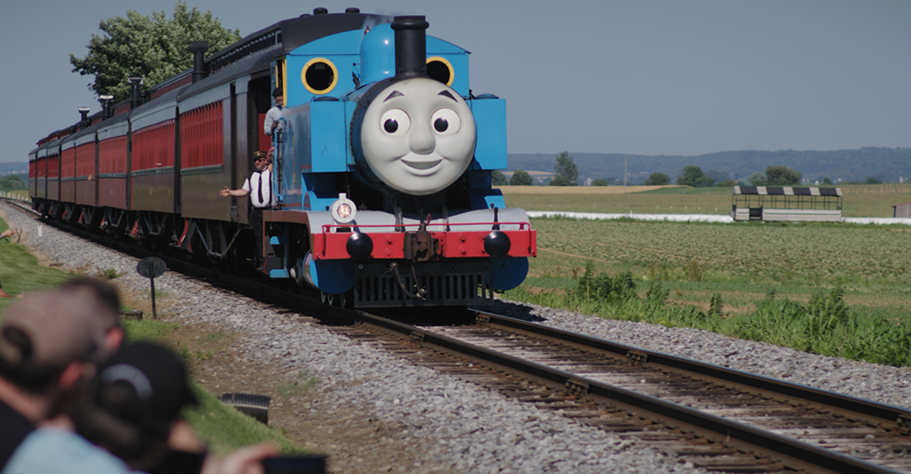The Minneapolis-based Friends of the 261 are providing four cars for a special charter Amtrak train that will operate from Seattle to Whitefish, Mont., via BNSF Railway’s ex-Great Northern line through the Cascades, also used by Amtrak’s Empire Builder. A musician chartered the special train for a birthday celebration. The train will depart Seattle in the morning and is expected to arrive in Whitefish well after dark.
The train will include an Amtrak unit and four cars, all painted in Milwaukee Road orange-and-maroon passenger colors, a scheme that was phased out by the Milwaukee beginning in 1955 when it adopted Union Pacific yellow as its passenger colors. The change came when the Milwaukee Road began handling Union Pacific streamliners between Chicago and Omaha. The Friends cars departed St. Paul on Amtrak’s Empire Builder on Jan. 22. This is one of longest charter trips ever operated by the Friends, and is unusual since it is a charter in winter when the cars are normally stored in the Twin Cities.
The four cars to be used on the special are:
• Baggage car No. 2450, built by American Car & Foundry in 1957 for the Union Pacific as a postal storage car. It saw frequent use on Union Pacific’s Cities streamliners and was later converted to maintenance of way car. The Friends of the 261 converted it into a concession/bar car and upgraded it to include a full bar, an on board sound system, LCD televisions, and GPS.
• Café lounge Wisconsin Valley built in 1953 by St. Louis Car Co. for the U.S. Army as a hospital car. Amtrak acquired and reconfigured it to a cafeteria lounge. The Friends of the 261 purchased the car in 2001; it now has lounge and table seating for 20, plus a full kitchen/cafe area.
• Super Dome 53, one of 10 Super Domes the Milwaukee Road purchased in 1952 from Pullman Standard. They were designed for use on the Chicago-St. Paul/Minneapolis Twin Cities Hiawathas and the Chicago-Twin Cities-Seattle-Tacoma Olympian Hiawatha, so car 53 has rolled through the Cascades many times.
• Skytop parlor lounge observation car Cedar Rapids designed by famed Milwaukee industrial designer Brooks Stevens. Among his famous designs were the Miller Brewing logo, the Oscar Mayer Wienermobile, and the Jeep Grand Cherokee Wagoneer. The Skytops designed by Stevens were built by the Milwaukee Road in 1948 at its shops in Milwaukee. Cedar Rapids was one of four Skytops used on the Chicago-St. Paul/Minneapolis Twin Cities Hiawatha streamliners. The Olympian Hiawatha carried sleeper Skytops built by Pullman Standard, but only one of those cars survives intact today.
The Chicago-Twin Cities-Seattle/Tacoma Olympian Hiawatha was inaugurated on June 29, 1947, as the successor to the heavyweight Olympian. The train was discontinued on May 22, 1961, an early casualty of airline and highway completion, and from the better-known streamliners of the Great Northern and Northern Pacific. The majority of the former Olympian Hiawatha route across Washington is abandoned.















Another factor in the ‘untimeliness’ of the Pacific extension was that anticipated freight traffic did not materialize. The completion of the Panama Canal in 1914 created an entirely new situation for ‘transcontinental’ railroads, and the Milwaukee, like the Western Pacific, were a bit late to the table.
Take a look at http://www.theweedroute.com A final ride by a couple of engineers with a Fairmount speeder on Milwaukee’s Pacific Extention from Montana thru Washington state before the line was later scrapped. An interesting trip indeed.
This is sooo cool. Chasing Colorado RRs kept me away from the Milwaukee unfortunately. But historical documents, and searching out the abandoned roadbeds, provides a flavor of what the Milwaukee was like. And prompted the question…why was this RR ever built?
One other comment. “The train will depart Seattle in the morning and is expected to arrive in Whitefish well after dark.” Should this not read, “expected to arrive in Whitefish sometime later.” (??)
Mr. Brown asks the question “why was this RR ever built?” Jim Scibbins observed that the Milwaukee was a gilt-edged Road in the early 20th. century when the extension was contemplated, with what one must assume was a high-powered board peopled with Armours and Rockefellers, who, one also might assume saw opportunities,
including challenging the Hill monopoly.
A little more history on the ex-Army/ex-Amtrak car. It was one of 52 ordered in 1952 to replace 52 Army Hospital Unit cars that were to be used for other service. %0 of them went to Korea for service there. Two were converted for Presidential service, one as the Communications car General Albert J Myer and the other as crew car Morn for the Comm car.
Those who are missing the running of the Milwaukee road on it’s Pacific extension should check out the “Open Rails” train simulator. The Rocky Mountain Division, The Idaho Division and shortly the Pacific Coast Division are available to drive with appropriate equipment (available at trainsim.com) Free. That will keep you distracted for a long time! (You can buy the Olympian Hiawatha passenger train for open rails here: http://www.valleypass.com/Sales/MILW1.htm)
Mr. Larson:
I’d be interested in hearing your evidence that the (streamlined) Olympian Hiawatha ever ran in sections. Where would the equipment have come from? Had it happened, I’m sure that Jim Scribbins would have documented it in his fine book, “The Hiawatha Story.” It is true that after WWII and into the early 1950s, the Milwaukee Road and Northern Pacific were in discussions with regard to operating their Olympian Hiawatha and North Coast Limited on alternate days, much as was the case with the City of Miami and South Wind on the Chicago-Florida run. While Mr. Scribbins does mention the fantasy 40-hour Chicago-Seattle trip as one proposal, the reality is that the Olympian Hiawatha was able to match the schedule of the Empire Builder early on after the trains were streamlined, this could not be sustained. With simply too many trains in Midwest-to-Pacific Northwest routes overall, the most inferior route – the Milwaukee Road – was first to cut service when the Columbian was discontinued in the mid-1950s, which eventually left the Olympian Hiawatha as the only train operating (on the Milwaukee) west of Minneapolis. Station stops were added to accommodate some former Columbian patrons and the train slowed in general. By the time the Olympian Hiawatha was axed in 1961, it was over 2 hours slower westbound than the Empire Builder and less than a half-hour faster than the North Coast Limited on its much longer route.
While I have heard that indeed the Milwaukee enginemen did tend to speed on the UP track between Spokane and Marengo (because the quality was far superior to that of the Milwaukee), pacing such trains would seem difficult – especially back in the day – due to lack of “adjacent” roads in the area. Indeed, outside the immediate Spokane/Cheney area, the UP route to Marengo even today is relatively inaccessible.
The myth of speed on the Milwaukee Road Pacific Extension appears to have a life longer than the railroad did. http://trainweb.org/milwaukeemyths/
Mr. Meyer,
As you are more informed than I on Milwaukee mythology, these comments derive from conversations or print items in the past.
With regard to Hiawatha sections, if they occurred, the Road would have had to cobble together a consist of who knows what.
As a sidebar, boarding the Boy Scout special at the old Everett St. depot to the 1960 Jamboree in Colo. Springs were pre-Hiawatha heavyweight coaches with functioning air-conditioning. The curious route was on the SW line to Freeport, where the IC took over after old IC diners were added, then on the IC to Omaha, thereafter CB&Q to Denver Union Station, which was packed with specials.
And here’s an amusing anecdote on “fast-running” when the Milwaukee had trackage rights on the UP west of Spokane….hoggers had to watch out for the UP dicks pacing them on the adjacent highway ready to wright up their tickets for speeding. The good old days.
To set the record straight with regard to the Milwaukee running a fast schedule to the West Coast, there were considerations attempting to match or exceed the Santa Fe’s, i.e., something on the order of 40 hours plus Chicago- West Coast. This was in the 1950’s when the Olympian Hi ran in more than one section in high season and ROW was 80 mph or above except through the mountains.
All other later matters are dreams and “pie-in-the-sky.”
Paul V….good dream. I always liked the Milwaukee Road…only thing is, the former Milwaukee right of way through the Bitter Roots, and Cascades wasn’t a route for high speed. While most of the line was built with a maximum grade of 1.50 percent, this in turn created lots of 3/4 loops, high trestles, reverse curves, which would certainly limit speed. Also, there are few high populous cities on their old route to woo riders. Then there’s the real biggie! Costs. Lot’s of costs. New rail line runs 1 million bucks per mile, just make it 25 mph allowable. Then there’s the cost of maintaining it, thru a very hard area to access. The final blow would be the government mandated Positive Train Control. Now there’ goes the pocket book for sure. But, hey. I like the way you think. It would be nice to see!
What is becoming a missed opportunity for Amtrak is acquiring the former Milwaukee right-of-way “The Olympian Hiawatha” ran on. With the line restored and upgraded, Amtrak could maintain a faster schedule without interference from freight trains. With grade separation, this could become the first long distance high speed rail line in the Americas.
Nowadays, it should be fairly easy to “paint” an engine temporarily using those “wraps” that are used to change the color of busses. Railfans need to be out and spotting between Seattle and Spokane when they might have enough light to take pictures. What would be REALLY SUPER would be if the “Friends of 261” could arrange a long trip to Seattle, down to Vancouver and then up thru the Columbia River Gorge on BNSF and back to Minneapolis thru Spokane and Idaho & Montana; all pulled by the MILWAUKEE 261 steam locomotive! I know I’d be trackside for that.
I know when it says, an Amtrak unit and four cars, all painted in Milwaukee Road colors, it means the coaches, but how cool would it be to have an Amtrak unit painted to match the cars?
Something tells me the birthday party will continue in Whitefish with skiing
Sounds like a great time !!!